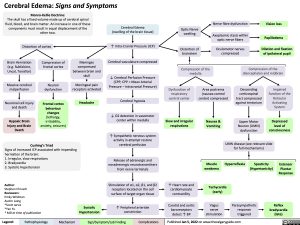Cerebral Edema: Signs and Symptoms
Monro-Kellie Doctrine:
The skull has a fixed volume made up of cerebral spinal fluid, blood, and brain matter. An increase in one of these components must result in equal displacement of the other two.
Cerebral Edema (swelling of the brain tissue)
↑ Intra-Cranial Pressure (ICP) Cerebral vasculature compressed
↓ Cerebral Perfusion Pressure (CPP; CPP = Mean Arterial Pressure – Intracranial Pressure)
Cerebral hypoxia
↓ O2 detection in vasomotor center within medulla
↑ Sympathetic nervous system activity in attempt restore cerebral perfusion
Release of adrenergic and noradrenergic neurotransmitters from nerve terminals
Stimulation of α1, α2, β1, and β2 receptors located on the cell surface of target organ tissue
↑ Peripheral arteriole constriction
Optic Nerve swelling
Distortion of brainstem
Compression of the medulla
Nerve fibre dysfunction
Axoplasmic stasis within optic nerve fibers
Oculomotor nerves compressed
Vision loss
Papilledema
Dilation and fixation of ipsilateral pupil
Distortion of cortex
Brain Herniation (e.g. Subfalcine, Uncal, Tonsillar)
Massive cerebral malperfusion
Neuronal cell injury and death
Hypoxic Brain Injury and Brain Death
Compression of frontal cortex
Neuron dysfunction
Frontal cortex behaviour changes (lethargy, irritability, anxiety, seizures)
Meninges compressed between brain and skull
Meningeal pain receptors activated
Headache
Compression of the diencephalon and midbrain
Dysfunction of respiratory control center
Slow and irregular respirations
Area postrema (nausea control center) compressed
Nausea & Vomiting
Descending corticospinal tract compressed against tentorium
Upper Motor Neuron (UMN) dysfunction
Impaired function of the Reticular Activating System
Depressed level of consciousness
Cushing’s Triad
UMN disease (see relevant slide for full mechanisms)
Signs of increased ICP associated with impending herniation of the brain:
1. Irregular, slow respirations
2. Bradycardia
3. Systolic Hypertension
Author:
Stephen Chrusch Reviewers:
Emily Wildman
Austin Laing
*Scott Jarvis
*Yan Yu
* MD at time of publication
Muscle weakness
Hyperreflexia
Spasticity (Hypertonicity)
Extensor Plantar Response
Systolic Hypertension
↑ Heart rate and cardiomyocyte contractility
Carotid and aortic baroreceptors detect ↑ BP
Tachycardia (early)
Vagus
nerve stimulation
Parasympathetic response triggered
Reflex bradycardia (late)
Legend:
Pathophysiology
Mechanism
Sign/Symptom/Lab Finding
Complications
Published Jan 5, 2022 on www.thecalgaryguide.com

